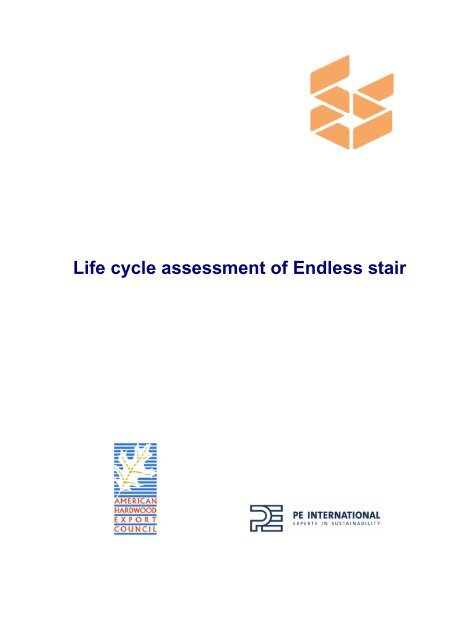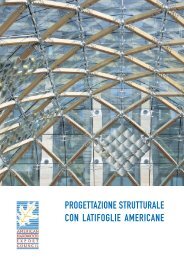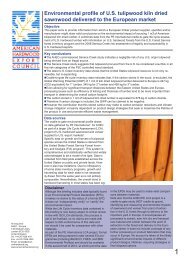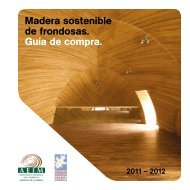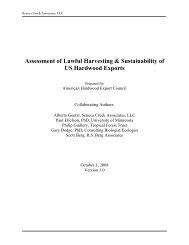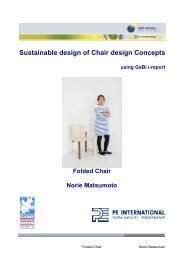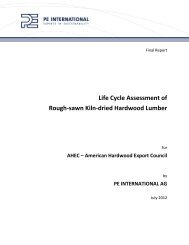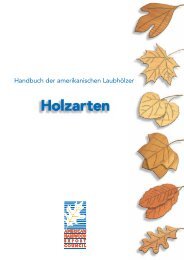here - American Hardwood Export Council
here - American Hardwood Export Council
here - American Hardwood Export Council
- No tags were found...
You also want an ePaper? Increase the reach of your titles
YUMPU automatically turns print PDFs into web optimized ePapers that Google loves.
Life cycle assessment of Endless stair
The <strong>American</strong> <strong>Hardwood</strong> <strong>Export</strong> <strong>Council</strong> (AHEC) has managed the project 'Endless Stair' fortheir latest London Design Festival. Endless Stair, a towering structure composed of 15 Escherlikeinterlocking staircases made from <strong>American</strong> tulipwood cross laminated timber (CLT), wasshowcased at the entrance to Tate Modern from 13th September 10th October 2013.TheEndless Stair at the London Design Festival has been initiated and managed by the <strong>American</strong><strong>Hardwood</strong> <strong>Export</strong> <strong>Council</strong> (AHEC). A towering structure composed of 15 Escher-like interlockingstaircases made from <strong>American</strong> tulipwood cross laminated timber (CLT), Endless Stair is beingshowcased at the entrance to Tate Modern from 13th September to 10th October 2013.The Life Cycle Assessment (LCA) of the Endless Stair builds on a two-year study, commissionedby AHEC and undertaken by PE INTERNATIONAL, to gather life cycle inventory data andassess environmental impacts associated with delivery of U.S. sawn hardwood into worldmarkets. The study was carried out in compliance with ISO 14040 and ISO 14044 for LCA. Thestudy involved an in-depth review of hardwood forestry and processing practices and a survey ofthe hundreds of U.S. companies engaged in the manufacture and export of hardwood products.The LCA study of <strong>American</strong> sawn hardwood covered 19 species representing more than 95% ofthe hardwood harvested in the US by volume and more than 95% of the wood volume exportedby AHEC members. In accordance with ISO requirements, the study was subject to criticalreview by an independent expert panel. The panel concluded that the substantial share ofprimary data collected ensured representative results for the US hardwood industry.Potential environmental impacts of the Endless Stair have been studied applying the life cycleassessment (LCA) method. The full life cycle model has been built up in the GaBi 6 softwaresystem and databases by PE INTERNATIONAL. Results have been calculated using the CMLimpact assessment methods.The LCA of the Endless Stair combined life cycle inventory data on<strong>American</strong> sawn tulipwood from the earlier study with data gat<strong>here</strong>d on-site during the process to
fabricate and install the structure in Europe. This includes data collected during CLT productionat Imola Legno in Italy, the fabrication of the stairs at Nüssli in Switzerland, and the installation atTate Modern in London.The full life cycle model was built using PE INTERNATIONAL's GaBi 6 software system anddatabases. Environmental impacts for the Endless Stair were calculated using the CML impactassessment methods. PE INTERNATIONAL's GaBi Envision modelling tool has been used tovisualise impacts at different process stages. GaBi Envision also provides a mechanism toassess how alterations in certain parameters (such as timber types, kilning methods, transportscenarios) will influence overall impacts.In addition to demonstrating the potential of tulipwood CLT, the Endless Stair forms part ofAHEC's efforts to promote a more scientifically oriented approach to environmental issues inmaterial specification and green building.Life cycle assessment (LCA) is a standardized scientific method for systematic analysis of flows(e.g. mass and energy) associated with the life cycle of a specified product, technology, serviceor manufacturing process system (ISO 2006). The approach aims at a holistic andcomprehensive analysis of raw materials acquisition, manufacturing as well as use and End-of-Life (EoL).According to the International Organization for Standardization (ISO) 14040/44 standard, an LCAstudy consists of four phases: (1) goal and scope; (2) life cycle inventory; (3) life cycle impactassessment; and (4) interpretation (ISO 2006).The goal and scope stage of LCA outlines the rationale and anticipated use of the results of thestudy. It defines the systems' boundary in terms of technological, geographical, and temporalcoverage, the attributes of the product system, and the level of detail and the complexity to beaddressed. This stage also sets out data requirements and assumptions and other similartechnical specifications.The life cycle inventory (LCI) stage qualitatively and quantitatively analyses, for the productsystem being studied, the materials and energy used (inputs) as well as the products and byproductsgenerated, the emissions into the environment, and the wastes to be treated (outputs).A typical LCI contains a large quantity of data for a specific functional unit (such as a tonne ofmaterial or a defined structure like the Endless Stair). Data includes, for example, how manytonnes of material were required to make each functional unit, how many litres of oil are burnt totransport each functional unit, and how much pollutant is emitted to the atmosp<strong>here</strong> during themanufacture of each functional unit. T<strong>here</strong> may also be data showing how much of eachfunctional unit ends up in landfill, or is recycled or burnt at EoL.The next stage, Life Cycle Impact Assessment, determines the extent to which each of thesedata items contributes to the various environmental "impact categories" such as global warming,acidification, or water pollution.The final stage of LCA involves “interpretation”. The LCA may be used to understand andmonitor potential environmental impacts of the product being studied. It may also be used toimprove production or product performance by focusing on the identified “hot-spots” of the lifecycle.
The following phases of the product life cycle have been analyzed:<strong>Hardwood</strong>: production of the <strong>American</strong> tulipwood lumber including forestry, sawing, dryingand transport processes in between;Transport to Europe: transport of lumber to port (by truck), to Italy (by ship) and toImolaLegno production site by truck (Imola);Glue for CLT: production of edge glue (vinyl based) and face glue (epoxy resin based) forCLT,Transport of glues for CLT: transport of edge and face glues by truck to ImolaLegno;CLT ImolaLegno: Manufacturing of CLT considering also electricity consumption (a significantpart from photovoltaic) and wooden waste recovery in on-site boiler;Transport to Nussli: transport of CLT by truck from Italy to Nussli site in Switzerland;Glues, metals, coatings etc: production of all other materials and components needed for theEndless stair structure, such as glue, coating, screws, nuts, bolts, concrete blocks, handrailand anti slip;Transport of glues, metals, coatings etc: transport of all components by truck to Nusslimanufacturing site;Nussli: construction of the endless stair structure (stairs, balustrades, pillars) using CLT andall other materials/components. Electricity consumption and wood waste recovery for heatingare also considered;Transport to London: transport of the Endless stair components to the festival in London;Design festival: construction of the concrete foundation for the Endless stair structure.Thefollowing phases of the Endless Stair life cycle have been analysed:<strong>Hardwood</strong>: production of the <strong>American</strong> tulipwood lumber including forestry, sawing, dryingand transport at each stage.Transport to Europe: transport of lumber to port in the U.S. (by truck), to Italy (by ship), andto the Imola Legno production site by truck.Glue for CLT: production of edge glue (vinyl based) and face glue (epoxy resin based) forCLT.Transport of glues for CLT: transport of edge and face glues by truck to Imola Legno.CLT Imola Legno: manufacturing of CLT considering also electricity consumption (asignificant part from photovoltaic) and wooden waste recovery in the on-site boiler.Transport to Nüssli: transport of CLT by truck from Italy to Nüssli site in Switzerland.Glues, metals, coatings etc: production of all other materials and components needed for the
Endless Stair, such as glue, coating, screws, nuts, bolts, concrete blocks, handrail and antislip.Transport of glues, metals, coatings etc: transport of all components by truck to Nüsslimanufacturing site.Nüssli: construction of the Endless Stair structure (stairs, balustrades, pillars) using CLT andall other materials/components. Electricity consumption and wood waste recovery for heatingare also considered.Transport to London: transport of the Endless Stair components to the London DesignFestival.Design Festival: construction of the 15.75 m3 concrete foundation for the Endless Stair.The LCA study includes the following inventory flows and environmental categories: acidificationpotential, eutrophication potential, global warming potential, stratospheric ozone depletion,photochemical oxidant creation potential (smog formation), primary energy demand (total andnon-renewable sources). In the selected impact categories the CML indicators were calculated.Acidification Potential (AP)This is a measure of emissions that cause acidifying effects to the environment. This damagesecosystems, w<strong>here</strong>by forest dieback is the most well-known impact. Acidification has otherdamaging effects such as nutrients being washed out of soils or an increased solubility of metalsinto soils. Unit: kg SO2-EquivEutrophication Potential (EP)This is a measure of emissions that cause eutrophying effects to the environment. Eutrophicationis the enrichment of nutrients in a certain place. The result in water is an accelerated algaegrowth, which in turn, prevents sunlight from reaching the lower depths. This leads to a decreasein photosynthesis and less oxygen production. In addition, oxygen is needed for thedecomposition of dead algae. Both effects cause a decreased oxygen concentration in the water,which can eventually lead to fish dying and to anaerobic decomposition. This can lead, amongothers, to the destruction of the eco-system. Unit: kg Phosphate-Equiv.Findings: The three most significant issues are the same as for acidification: transport to Europe,hardwood and CLT production. The "worst case" NOx emissions estimate of the boiler used inItaly makes the CLT production phase even more significant.Global Warming Potential (GWP)This is a measure of greenhouse gas emissions, such as CO2 and methane. These emissionsare causing an increase in the absorption of radiation emitted by the earth, magnifying thenatural greenhouse effect. Carbon stored in the final product and carbon removals from theatmosp<strong>here</strong> from biogenic sources are not modeled in this study. T<strong>here</strong>fore, biogenic carbondioxide emissions are modeled as carbon neutral (no impact of the GWP) as they are offset bythe uptake in biomass. Unit: kg CO2-Equiv.
Ozone Layer Depletion Potential (ODP)This is a measure that refers to the thinning of the stratospheric ozone layer as a result ofemissions. This effect causes a greater fraction of solar UV-B radiation to reach the surfaceearths, with potentially harmful impacts to human and animal health, terrestrial and aquaticecosystems etc. referring trichlorofluoromethane, also called freon-11 or CFC 11. Unit: kg CFC11-Equiv.Photochem. Ozone Creation Potential (POCP)A measure of emissions of precursors that contribute to low level smog, produced by the reactionof nitrogen oxides and volatile organic compounds (VOC) under the influence of UV light. Unit: kgEthene-Equiv.Primary energy demand from renewable and non-renewable resources (PED)A measure of the total amount of primary energy extracted from the earth. It is expressed inenergy demand from non-renewable resources (e.g. petroleum, natural gas, uranium, etc.) andenergy demand from renewable resources (e.g. hydropower, wind energy, solar, etc.).Efficiencies in energy conversion (e.g. power, heat, steam, etc.) are taken into account. Unit: MJnet cal. valuePrimary energy demand from non-renewable resources (PED non ren)A measure of the total amount of non-renewable primary energy extracted from the earth. It isexpressed in energy demand from non-renewable resources (e.g. petroleum, natural gas,uranium, etc.). Efficiencies in energy conversion (e.g. power, heat, steam, etc.) are taken intoaccount. Unit: MJ net cal. valueThe main findings can be summarized as follows:Carbon footprint of 13.2 tonnes CO2 equivalent excluding carbon storageThe GWP of the Endless Stair, including all processes to extract, transport and processmaterials, and to fabricate, deliver and install the structure in London, is 13.2 tonnes of CO2equivalent. This figure includes a significant offset of 9.9 tonnes of CO2 equivalent due toefficient waste management during the CLT production process. However, due to lack of data onthe EoL of the Endless Stair, it excludes the biogenic carbon stored in the structure which isestimated at 14.5 tonnes of CO2.<strong>Hardwood</strong> processing largest single factor contributing to carbon footprintNot surprisingly, given that hardwood is by far the most visible component of the Endless Stair,hardwood production processes contribute a significant share of overall environmental impact.These make the single largest contribution to GWP, accounting for emissions of 7.6 tonnes ofCO2 equivalent. A large part of this is due to use of electricity during sawing and to power fansduring the kiln drying process. GWP during the hardwood lumber production process issignificantly mitigated by burning of offcuts and other wood waste which contributes on average90% of thermal energy production for kilning of hardwoods in the United States.
Efficient waste management significantly reduces some environmental impactsDuring manufacturing at Imola Legno and Nüssli, those parts of the hardwood that could not beused in the structure were diverted for alternative products and to produce thermal energy. Thisuse of material in other processes helps to avoid consumption of fossil fuel in othermanufacturing systems. As a result, significant environmental savings are achieved in relation toglobal warming and non-renewable primary energy demand.The downside of wooden waste energy recoveryAlthough wooden waste energy recovery reduces the carbon footprint, the NOx emissions ofboilers may make a significant contribution to AP and EP. In the current LCA study a “worstcase” estimation was used for NOx emissions resulting from wooden waste recovery in Italy toavoid hiding this potential impact.Environmental impact of transportEfficient processing and waste management at other stages of the supply has resulted intransport contributing a significant share of the overall impact of the Endless Stair in severalimpact categories, including AP, EP and GWP. Another factor increasing the role of transport isthe relatively limited number of manufacturers capable of producing hardwood CLT anddelivering such an innovative one-off exhibition project. This resulted in products having to bemoved first to Italy and then to Switzerland before delivery to the UK.Relatively high proportion of impact due to non-wood materialsA notable feature of the GWP of the Endless Stair is that a relatively high proportion isattributable to materials other than the CLT despite their low visibility. For example, the concretefootings used during installation in London, assumed to be locally sourced, had a GWP of 4.1tonnes CO2 equivalent (around 260 kg CO2 equivalent per cubic meter). The GWP of all nonwoodmaterials used by Nüssli in Switzerland to assemble the structure was 2.2 tonnes CO2equivalent. The glues for CLT production also had a relatively significant contribution to GWP of1.7 tonnes CO2 equivalent. This was due mainly to the need to use epoxy resin for face flue.This glue type would be replaced in industrial applications by polyurethane based glue which hasaround 30% less GWP and primary energy demand.Use of solar energy leads to reduced environmental impactUse of photovoltaic energy for electricity generation during CLT production at Imola Legno madea significant contribution to improved environmental performance across several impactcategories.Acidification Potential highly dependent on sulphur content of marine fuelsA large part of the AP of the Endless Stair is attributable to burning of marine fuels with highsulphur content during shipment from the United States into Europe. The extent to which thisimpact can be reduced for any materials shipped from overseas is very dependent oninternational progress to reduce sulphur content. Efforts are being made to progressively tightenrequirements under the International Convention for the Prevention of Pollution from Ships(MARPOL). A target has been set that the sulphur content of any fuel oil used on board shipsshall not exceed 0.5% from 2020 onwards. This target is a long way from being metinternationally and the Endless Stair study uses a figure of 2.7% which is the assumed currentglobal average.
23% of Acidification Potential of the Endless Stair is created during production of hardwoods.This is primarily due to emissions of sulphur dioxide and NOx during production of energy forsawing and kiln drying in the United States.The 9% of Acidification Potential contributed by CLT production in Italy is due to the assumptionof a "worst case" estimate for boiler NOx emissions in Italy.Total Eutrophication Potential of the Endless Stair is 24.4kg of phosphate equivalent. Perhapssurprisingly, hardly any of the eutrophication associated with the Endless Stair is linked to thegrowth of tulipwood. Fertilisers are very rarely used to encourage growth of <strong>American</strong> hardwoodswhich thrive under natural conditions. Instead, nearly all eutrophication potential of the structureis due to NOx emissions during burning of fuels for transport and processing of materials.38% of Eutrophication Potential is created during transport of tulipwood from the kilning locationin the United States to Imola Legno in Italy. 20% is created during production of kiln dried sawnlumber in the United States. The "worst case" NOx emissions estimate of the boiler used in Italymakes the CLT production phase relatively significant, also accounting for 20%.
production process as a result of the thermal recovery of wooden waste. Energy consumptionduring hardwood production (mainly during kilning) and transport to Europe are the main factorscontributing to non-renewable energy demand. However other issues are also significant,including the face glue for CLT, the materials used in Nüssli (notably the metal screws) and theconcrete used during installation at the Design Festival.Designers have the possibility to define new scenarios with GaBi Envision and monitor theenvironmental peformance.
Original<strong>Hardwood</strong> production United StatesScenario parametersScenario1Scenario2Forest to sawmill 96,561 96,561 distance (km)Sawmill to kiln 117,48 117,48 distance (km)Kiln efficiency 53 53 %Kiln thermal energy 25 25 kWh/day, MBF, inchKiln power 17 17 kWh/day, MBF, inchBiomass for kiln thermal energy 90 90 %Natural gas for kiln thermalenergyTransport to Europe10 10 %Quantity 54,43 54,43 volume of <strong>American</strong> tulipwoodlumber (m3)Kiln to US pport 655 655 distance (km)US port to Europe 7735 7735 distance (km)Europe port to CLT production 225 225 distance (km)Glues for CLTEdge glue 165,5 165,5 mass of vinyl based glue (kg)Face glue 243,2 243,2 mass of epoxy resin based glue(kg)Transport glues for CLTEdge glue 230 230 distance of edge glue supplier(km)Face glue 1170 1170 distance of face glue supplier (km)CLT ImolaLegnoSelection and cross cuttingLoad 1 1 load (kW)Time 50 50 working time (h)MoldingLoad 45 45 load (kW)Time 22 22 working time (h)Edge gluing and lateral pressLoad 5 5 load (kW)Time 150 150 working time (h)Intermediate sandingLoad 75 75 load (kW)Time 8,5 8,5 working time (h)
Waste 60 60 mass of wooden waste (kg)Milling of threadsLoad 4 4 load (kW)Time 33 33 working time (h)Waste 21 21 mass of wooden waste (kg)Milling of ballustrade - solidLoad 4 4 load (kW)Time 16 16 working time (h)Waste 20 20 mass of wooden waste (kg)Chamfer miter joint per stepLoad 7 7 load (kW)Time 7 7 working time (h)Waste 25 25 mass of wooden waste (kg)Chamfer miter joint per ballustrade - solidLoad 7 7 load (kW)Time 7 7 working time (h)Waste 25 25 mass of wooden waste (kg)Cutting infill pieceLoad 7,7 7,7 load (kW)Time 18 18 working time (h)Waste 374 374 mass of wooden waste (kg)Planing infill pieceLoad 13 13 load (kW)Time 18 18 working time (h)Waste 20 20 mass of wooden waste (kg)Milling infill piece (drilling holes)Load 4 4 load (kW)Time 26 26 working time (h)Waste 5 5 mass of wooden waste (kg)Materials to NussliAntislip 40 40 mass of antislip (kg)Concrete block mass 310,5 310,5 mass of one precast concreteblock (kg)Concrete block number 10 10 number of precast conceret blocksCoating 100 100 mass of coating (kg)Glue 16 16 mass of glue (kg)Handrail mass 1 1 mass of handrail (kg/m)Handrail length 100 100 lenght of handrail (m)Screws, nuts, bolts 245 245 mass of metal parts (kg)Transport materials to NussliAntislip 100 100 distance (km)Coating 570 570 distance (km)
Concrete block 20 20 distance (km)Glue 640 640 distance (km)Handrail 130 130 distance (km)Screws, nuts, bolts 100 100 distance (km)Transport to LondonDistance 1050 1050 distance (km)Payload 17,3 17,3 truck payload (t)Utilisation 0,7 0,7 utilisation ratio of truckDesign festivalVolume 1,575 1,575 volume of concrete block (m3)Number 10 10 number of blocksElectricity 0 0 electricity (kWh)


